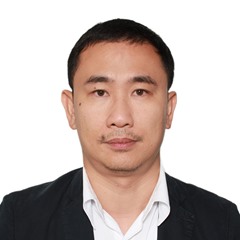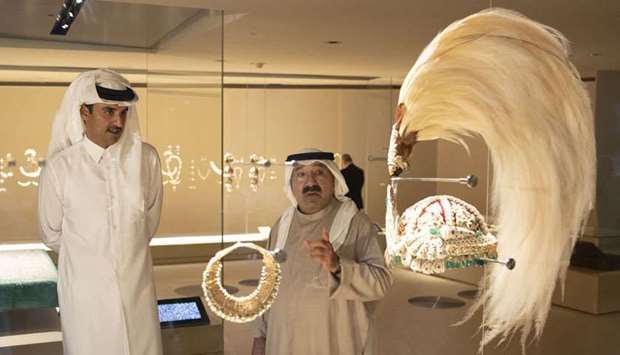*His Highness the Amir inaugurates the National Museum of Qatar
*The immersive new museum, housed in an architectural masterpiece by Jean Nouvel, embraces as its centrepiece the restored historic Palace of Sheikh Abdullah bin Jassim Al Thani (1880-1957), son of the founder of modern Qatar
His Highness the Amir Sheikh Tamim bin Hamad al-Thani officially inaugurated on Wednesday the National Museum of Qatar (NMoQ) – a desert rose-inspired architectural masterpiece that tells the story of Qatar and its people in an immersive way through its 11 interlinked galleries.

Qatar News Agency (QNA) reported that the ceremony was attended by the Amir’s Personal Representative His Highness Sheikh Jassim bin Hamad al-Thani, His Highness Sheikh Abdullah bin Khalifa al-Thani, His Highness Sheikh Mohamed bin Khalifa al-Thani, HE Sheikh Jassim bin Khalifa al-Thani, HE the Prime Minister and Interior Minister Sheikh Abdullah bin Nasser bin Khalifa al-Thani, HE the Speaker of the Shura Council Ahmed bin Abdullah bin Zaid al-Mahmoud, and Qatar Museums (QM) chairperson HE Sheikha Al Mayassa bint Hamad bin Khalifa al-Thani.

Turkish Vice-President Fuat Oktay, French Prime Minister Edouard Philippe, Kuwait's First Deputy Prime Minister and Defence Minister Sheikh Nasser Sabah al-Ahmad al-Sabah, Oman’s Heritage and Culture Minister Sayyid Haitham bin Tariq al-Said, Germany’s Minister of State for International Culture Michelle Muntefering, former President of France Nicolas Sarkozy, Rome Mayor Virginia Raggi, Azerbaijan’s adviser Souda Mohamed Aliev were among those present.

A number of sheikhs, ministers and heads of diplomatic missions accredited to Qatar, several prominent figures in politics, culture, art, media, and a number of heads of companies and international institutions, directors of museums, academics, film directors, and other celebrities from around the world also attended the opening.
Speaking on the occasion, His Highness Sheikh Tamim paid tribute to the initiative of His Highness the Father Amir to expand the museum, the original building of which was built in 1975 in the old palace of Sheikh Abdullah bin Jassim bin Mohamed al-Thani, and above all his vision and launching a process in which modernity is integrated with the Arab and Islamic civilisation and Qatari heritage.

The new building, which includes and surrounds the old palace, is designed by architect Jean Nouvel. The innovative design is based on a natural phenomenon caused by a sand formation known as the desert rose, called in Qatar as Qahuf.
Sheikh Tamim pointed out that Qatar builds museums not to store art collections, or showcase the past, but to enlighten the public, residents and visitors, with the country’s past and present and position in the world.
“The museum presents our formulation of our past, our environment and our experiences in the perspective of the present. It is therefore a formulation of our Arab-Qatari cultural identity, and museums are not repositories of the past, but our present is embodied in how we read our history and position within humanity in general.

“The National Museum tells the story of our people. It also encourages the discovery of the nature of the country and its historical effects, economy and urban development, and much more. It provides a space to reflect on what Qatar has done and what it aspires to do.
“By sharing this information with visitors, we want museums and other cultural institutions to create a climate of dialogue with ourselves and others, giving our people a wisdom voice in shaping our future.
“The National Museum is the product of a collective work of many institutions and individuals, and represents what we are as a country characterised by open dialogue and co-operation in all fields.
“Through our programmes and educational exhibitions, we will add a great addition to Qatar's growing cultural landscape, including our university institutions, our pluralistic media, our national library, which contains a million books in its prestigious building opened last year, the annual book fair, as well as festivals and numerous artistic activities in Katara, old souqs, art galleries, and many other institutions and initiatives.

“Our goal is to build a knowledge-based economy and human development. The economic model we offer and the richness of sport and culture are, in our opinion, the best indicator of the healthy growth of any country. The rich cultural scene has become an important economic component of tourism, enriching the visitor by adding culture to entertainment and relaxation.
“Qatar is committed to the work programmes to host the 2022 World Cup - a celebration of sport, arts, culture and the spirit of the community with the solidarity and unity of all football fans and people of goodwill from all over the world.
“Qatar has made many achievements for the benefit of its citizens, in terms of quality of life, and in the fields of education, health, environment and others. It continues to welcome people from all over the world. Progress through diversity and tolerance remains at the core of our commitment to the development and nurturing of a harmonious and prosperous society, guided by human values.

“Qatar has become much stronger since June 2017. Its citizens and residents work together to build the country, strengthen the economy, maintain human dignity and defend the truth, get to know each other and exchange experiences, and most importantly, they exchange friendship and respect,” Sheikh Tamim said, QNA added.
Among the well-known figures and celebrities who attended the official inauguration of NMoQ on Wednesday were Jean Nouvel, architect; Jeff Koons, American contemporary artist; Takashi Murakami, Japanese contemporary artist; Olafur Eliasson, Icelandic-Danish artist; Victoria Beckham, businesswoman and fashion designer; Natalia Vodianova, supermodel, philanthropist and entrepreneur; Diane Von Furstenberg, fashion designer; Rem Koolhaas, architect; Johnny Depp, actor; Jose Mourinho, professional football coach; Carla Bruni, singer-songwriter and supermodel; Naomi Campbell, businesswoman and model; Olivier Rousteing, French fashion designer and the creative director of Balmain; Jacques Herzog, architect; and Pierre de Meuron, architect.


